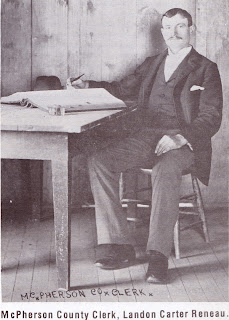Sunday Stories: History of McPherson County, Part 3
Excerpted from the McPherson County: Facts, Families, Fiction; Established in 1890
A HISTORY OF MCPHERSON COUNTY
The following was an essay done for school credit by John Kramer.
On November 3, 1891, the people of the county voted to annex
the territory now known as Arthur County and on January 1, 1892, it became a part
of McPherson County. This entire area was made into one precinct and was known
as Arthur Precinct.
In the fall of that year the name of the county seat was
changed to Tryon and a post office was established in the town. It is not
definitely known how the town came to be named Tryon, but it is believed it was
named after William Tryon, an early colonial governor.
During the 1890’s, there was a drought throughout Nebraska.
Although it was not as severe in this county as elsewhere, it retarded
settlement and growth. By 1900 the county’s population had increased by only
116 people to make the total population 517.
In 1895 Tryon had only two buildings, the courthouse and the
home of Jay Smith, the county treasurer. Jay Smith’s house contained the only
newspaper in McPherson County at this time, The McPherson County News. D.P.
Wilcox had established in 1889, making it the first business established in
this county, but sold it to Smith soon after. Smith sold it to George Daly in
1895 and it remained in his family until 1922 when it was sold to the Snyder
family. The building holding the paper was completely destroyed by fire in
1926. This destroyed most of the old copies that would have given a great
amount of facts concerning the first years that the county was in existence.
In 1897 L.C. Reneau established a simple store in Tryon. It
carried only a few necessities and the county had several other stores that
were similar in nature.
In 1903 Mike David established this county’s first permanent
store. This first store was made of sod and stood a few rods north of the
present day David Store. In 1911 Mike David bought the Reneau General Store and
located his business there until 1916 when he built the store that Taft Haddy,
his son-in-law, now operates.
The Kinkaid Act, which was enacted by Congress in 1904, did
much to speed the settlement of the entire Sandhill area. The act, which was
sponsored by Moses P. Kinkaid, made it possible for any settler to obtain one
section of land by living on it for five years.
In other parts of the state the big ranches bitterly opposed
the “Kinkaiders”, but here this was not so. Some of the ranchers even helped
the “Kinkaiders” by giving them employment and feed for their livestock. Most
of those who settled on the ranges of the Whitewater or Triangle ranches later
sold out to these ranches for satisfactory prices.
The rapid influx of settlers at this time increased the
population of this county to 2,470 people in 1910. The county seat grew to
become a bustling frontier city. In 1907 a schoolhouse was built, in 1910
another store, and also in the early 1900’s a lodge and the Tryon Hall were
built. The store that was built was known as the Tryon Leader and was owned and
operated by I.C. Heldenbrand.
A period of good crop years helped the “Kinkaiders” to get a
good start and the county prospered greatly. Times were so prosperous and there
were so many people that there was a shortage of teachers and schools. Tryon
built a new two-room schoolhouse in 1914 to help remedy its problems and much
the same thing happened throughout the county. The schoolhouse that had served
Tryon up until this time was sold to Will M. Dunn and was used for the printing
office until 1926 when it was destroyed by fire.
Many of the settlers became deeply in debt to the stores for
the necessities that they needed. Since they would have no money until they
sold the land after five years of residence, they were quick to secure loans on
their land from the various lending agencies. The two lending agencies that
operated in this county were Bills & Cline and The Cornelius Company, both
from Hastings, Nebraska. In 1918 most of the loans were refinanced in the
Birdwood National Farm Loan Association.
These loans were a boon to many of the settlers while some
merely used them as a means to sell out. Many of the settlers that stayed and
paid up the loans became quite prosperous and many of their descendants are
still in the county today on these original holdings. Although some of the land
did fall into the hands of non-resident owners, in a few years this land was
purchased by resident operators who were expanding their holdings.






Comments
Post a Comment